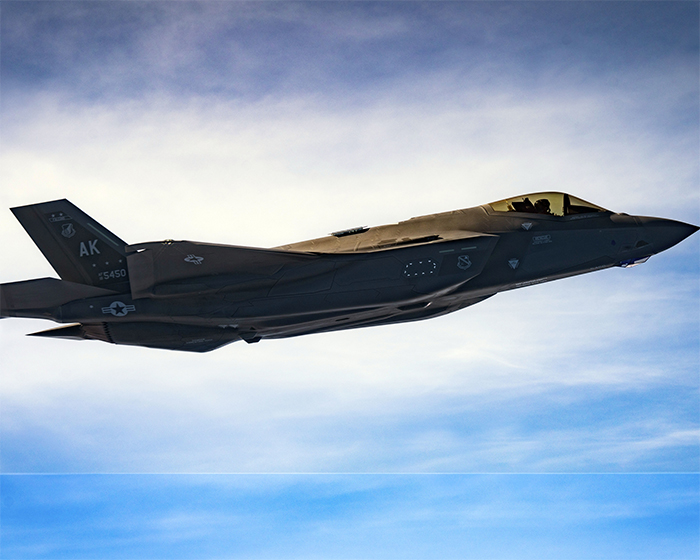
Peter Zeihan: Europe Goes Nuclear
We’ve got two major developments in Eurasia. We’re talking about Ukraine disabling two ships in the Caspian Sea and Poland getting EU approval to build…
Thought Leader: Peter Zeihan

President Joe Biden recently signed the 2022 National Defense Authorization Act (NDAA) totaling $740 billion, an increase of 5% in military spending over last year’s budget. It is the largest NDAA in U.S. history, but does it adequately fund the real needs and concerns which face our military today?
As the world edges closer to possible confrontation with China, Russia, or both, these near peer competitors are gearing up to challenge the will, strength and resolve of America’s national security and political system. This geopolitical backdrop underscores the importance of addressing our future military arsenal to meet these threats.
Air supremacy will be one of the most important aspects that will define future warfare. The advanced capabilities of the F-35 fighter jet represent a growing and important portion of the Department of Defense’s tactical aviation arsenal. The F-35 gives our pilots an advantage against any adversary and enables them to execute their mission. One of the most well-known and effective military solutions in the U.S. arsenal, it operates from 21 bases worldwide, and there are more than 655 F-35s in service.
The main component of success for this aircraft is the F135 engine. The F135 has achieved numerous engineering feats, including increased thrust and thermal management capacity, adaptive controls, advanced materials, and design-for-sustainment modular architecture, consisting of universal parts that are more easily manufactured efficiently.
The first production of this engine began in 2009 but planned air vehicle growth would exceed the current engine’s capabilities by the end of this decade. A propulsion upgrade is now needed, and the Navy and Air Force are at a crossroads for the future modifications of this engine.
Pratt & Whitney, the current provider for the F135 engine, has proposed an Enhanced Engine Package that will improve performance while relying on a similar supply chain, infrastructure, and sustainment network. Meanwhile, some within the Biden Administration are exploring the implementation of an entirely new propulsion system known as the Adaptive Engine Transition Program (AETP) that will cost billions of taxpayer dollars and jeopardize current production efforts.
The Secretary of the Navy and the Secretary of the Air Force, in coordination with the Under Secretary of Defense for Acquisition and Sustainment, are required to submit reports on the integration of the AETP propulsion system or other advanced propulsion systems into F-35 aircraft. Of note is the importance outlined in the NDAA, which limits the Secretary of Defense from entering a performance-based logistics sustainment contract for the F-35 aircraft or engine until first certifying that such a contract would reduce costs or increase readiness or availability.
Therein lies the main challenge to the proposed AETP make-over – sustainment costs. A critical aspect of the F-35 program is maintaining or reducing sustainment costs. It makes little sense, in an era when everything costs more to produce, to embark on a new design for a propulsion system that will take at least half a decade to make operational.
While the AETP is an interesting and promising concept that will likely have applications for the Navy’s Next Generation Air Dominance (NGAD) fighter aircraft initiative, it has probably passed its period of usefulness for the F-35. The expectation is to produce and utilize AETP, have it operational in ten years, and make it available to our friends and allies soon after. But the F-35 sustainment system will not support such an endeavor. A second engine line may have made sense many years ago, but now it will be prohibitively expensive. Furthermore, the F-35 Joint Program Office says the new AETP engine would not work on the Marine flight variant and might not work on the Navy variant, increasing costs and diminishing interoperability between the services.
There remains a “sense of urgency” within our military to stay ahead of America’s adversaries but designing an entirely new engine today with cost overruns, testing, etc., plus designing an entirely new supply chain to support the aircraft currently in use by our friends and allies around the world, does not make sense. Our warfighters and taxpayers would be better served by building upon the successes of past programs and improving them when needed instead of spending vast amounts of time and money on an entirely new modernization program.
Peter Zeihan: Europe Goes Nuclear
We’ve got two major developments in Eurasia. We’re talking about Ukraine disabling two ships in the Caspian Sea and Poland getting EU approval to build…
Thought Leader: Peter Zeihan
Dr. Sanjay Gupta’s Top Health Stories of 2025
From the resurgence of measles to a new way to treat pain, 2025 was a challenge for public health while still offering moments of hope. Sanjay…
Thought Leader: Sanjay Gupta
Ian Bremmer: The state of global conflict in 2025
On GZERO World, Ian Bremmer takes a hard look at the biggest global crises and conflicts that defined our world in 2025 with CNN’s Clarissa…
Thought Leader: Ian Bremmer

